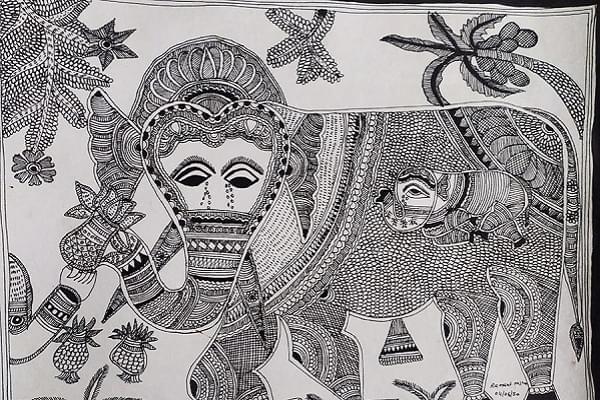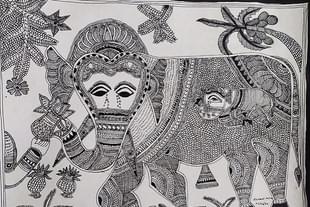News Brief
The Cries For ‘Ma’ Elephant: An Artist From Mithila Depicts Heart Rending Tragedy Of The Tusker In Kerala
Swarajya Staff
Jun 05, 2020, 02:22 PM | Updated 02:19 PM IST
Save & read from anywhere!
Bookmark stories for easy access on any device or the Swarajya app.


The visual language of Mithila (Bihar) has risen to give a poignant expression to the tragedy and death of the pregnant elephant in Kerala. Remant Mishra, an artist known for his contribution to the art of Mithila, has depicted the incident in a timely take on case.
It is a bold expression of the pain and agony of the elephant and her unborn child in the Madhubani style.
He has successfully attempted the storytelling of the despicable, disturbing and inhuman act, where the elephant was killed after a pineapple stuffed with firecrackers was given to her by "three suspects".
Mishra's work was shared by Jaya Jaitly on Twitter. The work -- an imposing response to the incident that has stirred outrage from all sections of the society across India, is dated 4 June.
Mishra's work of art comes across as a significant intervention on World Environment Day (which falls today).
Our folk artists are surpassing themselves in bringing out current day themes. Remant Mishra poignantly depicts the recent tragedy of the pregnant female elephant killed by a pineapple stuffed with firecrackers. pic.twitter.com/z6VYuTitsI
— Jaya Jaitly (@Jayajaitly) June 4, 2020
Jaitly is known for her commitment to the propagation of the arts, artists and artisans practising the indigenous narratives across India.
Jaitly hails from Kerala, has travelled and worked -- from Kashmir to Kerala -- for the propagation of the folk arts and crafts. She lives in Delhi.
For decades, she has worked for the rights, space, opportunities and remuneration that the artists deserve.
Mishra's depiction of the gruesome incident that took place in Kerala is a moving one. He has shown the pregnant elephant in tears. He has shown the growing fetus in tears and curling into the mother.
The trunk of the fetus is depicted as distinctly formed -- and has "Ma" (mother) written on it -- as if to give an outlet to the muffled cries from the womb.
The motif of pineapple is repeated, perhaps to show the breaking of the animal's trust. The pineapple being fed to her would eventually cause death. The one being fed to the elephant is shown to be the most beautiful and intricately lined. The other two representations of the pineapple -- less ornate.
Mishra has depicted the facets of the region's flora in the work. With these, the message -- of the animal being harmed in her own habitat by the people of the region -- comes out strongly.
Mishra's skills and art come from a strong lineage of artists in the family and those working relentlessly in his region. He is one of the ace artists practising the Madhubani style that comes from and thrives in Bihar.
Madhubani, among other indigenous styles of art practised by artistes in the interiors of Bihar and other states, is being used to interact with themes and subjects of contemporary value.
It is celebrated by Bihar as heritage and in the state's cultural interaction with other states and styles. It has also been used to give vigour and colour to Madhubani and its railway station.
Mishra's depiction pops up amid a scenario when Covid-19 has become one of the current themes that is pushing artists to respond in the indigenous styles of drawing and painting.
The Madhubani style is also being used for Covid-19 masks innovatively by artists and people who are sourcing motifs for the making of these masks.
Years and decades from now, these depictions will be of huge social value to the public in general and Indian contemporary art in particular.




